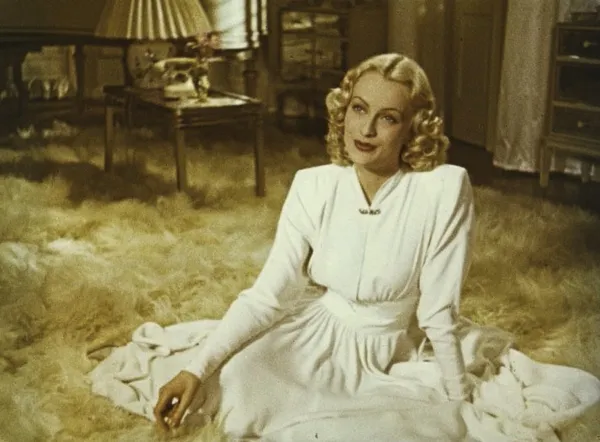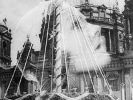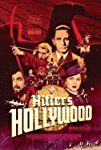Eye For Film >> Movies >> Hitler's Hollywood (2017) Film Review
Hitler's Hollywood
Reviewed by: Anne-Katrin Titze

Night and fog as in the title of Alain Resnais's groundbreaking 1956 documentary about the Nazi concentration camps, dominate the scenes chosen for Hitler's Hollywood in rather specific ways. The fog invades the visuals and the night in the majority of songs. Blurred edges, fades, mist rising in a perennial Erlking realm dominate the many dream sequences.
Rüdiger Suchsland's follow-up to his look at Weimar cinema, From Caligari to Hitler, enlightens about the cinema of the Third Reich with carefully selected clips from the more than thousand films produced between 1933 and 1945. The English version of this essay film is narrated by Udo Kier, who at times seems to whisper a revelation into our ears.

No lyrics of the night accompany the trance-like jester dance in GW Pabst's Paracelsus from 1943. A town becomes mesmerised and mobilised as they sway after the shabbily dressed clown who holds all the power. Pabst's tickets to come to the US were already booked when he was trapped in Germany by the outbreak of the war.
One of Suchsland's theses, that Propaganda Minister Joseph Goebbels, who controlled the country's entire film industry, copying Hollywood with a German touch, turned all of Germany into a movie set, directed by him, is far reaching.
Heinz Rühmann, the Nazi era's beloved comedian, most famous for playing the ordinary little fellow, seems forever suspended between child and old man with nothing in-between. Suchsland begins his inquiry with a clip from Karl Hartl's 1937 Der Mann der Sherlock Holmes war. Hans Albers and Rühmann play impostors who pretend to be Sherlock Holmes and Dr. Watson.
They whistle, wrapped in dressing gowns, striped for the manly Albers, polka-dotted for the droll Rühmann, as they exchange bathtubs by sauntering from one side of the hotel suite to the other. The song they sing - self-confidence in tact - proclaims, that "Jawoll meine Herren", tomorrow the world will belong to them. They will "soap up" anyone in their way.
It is a thoroughly chilling start that uses the ridiculous to point in the direction of the work that we, now, today, have to do when dealing with this particular past. The chronology of the films is jumpy, we zigzag through the years between '33 and '45. Some leaps are thematically more understandable than others. Newsreel footage interspersed never lets us forget the world beyond the pictures. An astonishing number of songs speak of the night.
Hungarian dancer Marika Rökk, one of the most prominent musical performers during the Third Reich, sings "In der Nacht ist der Mensch nicht gern alleine", that human beings prefer not to be alone at night. For the revue number she is wearing a low-cut dress, below the navel low, with a see-through veil panel in the middle. Instead of alluring, she looks cut in half. The enjoyments of the night have become absurd and hysterical by 1944.
Hans Albers, Germany's blue-eyed adventurer idol, the biggest male star, the ideal of masculinity with strength and a twinkle in his eye always has a heavy load to carry. A Teutonic combination of Spencer Tracy and Jean Gabin, he foretells in his song of the night what can happen in Hamburg's amusement quarter at 12:30am in Helmut Käutner's Große Freiheit Nr. 7 (Port Of Freedom) also from 1944.
We are being lured into an unforgettable nightmare sequence that has no equal in film history. Comrades call the Albers character out to sea, a woman from his past asks him to stay and a young girl, innocent and promising a new start, appears as the rescuing angel in the same window. The harbor aglow in Agfacolor. This picture, as well as Käutner's Romanze In Moll and Unter Den Brücken are among the most shimmeringly ambivalent and provocative works made in Germany.
"Die Nacht ist nicht allein zum schlafen da" - the night isn't only meant for sleeping, states the central song from Hans Steinhoff's film Dance on the Vulcano (Tanz Auf Dem Vulkan) from 1938. Gustaf Gründgens, the brilliant actor who inspired Klaus Mann to write Mephisto about him, here plays Jean-Gaspard Debureau, the charismatic 19th century French mime Pierrot, who rebelled against the King. The record of the song by Theo Mackeben was banned by Goebbels but it did remain in the movie. Standing next to the guillotine, the song is used as a wake-up call. Ships aren't meant to stay in the harbor, the night can be used for more important things than sleep.
"Alone am I in the night", Zarah Leander, the Swedish singer with the dark, seductive voice croons in Detlef Sierck's Puerto Rico-set melodrama La Habanera from 1937. The director, who was soon to emigrate to Hollywood and change his name to Douglas Sirk, creates a mood of feverish longing, brought about by an ill wind who told the eternally lonely woman the song.
Of course, Hitler's Hollywood does not ignore the more obvious anti-Semitic, ideologically vile movies of the time with clips from The Eternal Jew, Jud Süss, and The Rothschilds. Leni Riefenstahl's Triumph Of The Will is interwoven with lesser known but not less significant pictures. Cinema was used by the Reich with perfidy. A film promoting their euthanasia program, Wolfgang Liebeneiner's Ich klage an (I accuse) from 1941, wrapped their legal agenda into a courtroom drama and love story about a man and his deadly ill, suffering wife.
Siegfried Kracauer, Hannah Arendt and Susan Sontag are quoted but it is ultimately up to us to make sense of the forests, the bodies in motion, the cityscapes showing ordinary pre-war places that no longer exist, tanned male faces, Marianne Hoppe awakening, Johannes Heesters charming the ladies in top hat and tails, Ferdinand Marian crossing the line, camels crossing the desert, people singing that they want to be a chicken, Hitler standing by the Eiffel Tower, the Wannsee one year before the Conference, total war and the Titanic sinking.
Hitler's Hollywood, while pointing to some major ideas, leaves enough room for viewers to question the fascination with some of what we see. It is precisely the moment when we fall under the spell of these images that is most important and most revealing. What is unique about this cinema? The longing for death, the glorification of sacrifice has not been celebrated to such an extent anywhere else on screen. The waiting woman is discussed as a trope and yet, quite a few of the films show women actively pursuing careers, happily networking with other women, as is the case in the only film Ingrid Bergman made in Germany at the time, Carl Froelich's Die Vier Gesellen (The Four Companions) in 1938.
Slovenian philosopher Slavoj Žižek (The Pervert's Guide To Ideology), who gets a thanks in the end credits of Hitler's Hollywood, once told me that Veit Harlan's Opfergang was his all time favourite film. Referred to by Suchsland as the 'German Vertigo', it is presented here in clips of breathtaking beauty. Harlan, the director of much more obvious propaganda films, such as the notorious Jud Süss and the final film of the Third Reich, Kolberg, packs ideology into a triangular relationship in Opfergang. Irene von Meyendorff and Harlan's wife Kristina Söderbaum, two blond beauties, represent two female ideals of the time. Intellectual and athletic, Nietzsche-loving and equestrian, they are two poles Carl Raddatz's character is fatally drawn to.
Suchsland doesn't go deep into the plot surrounding the themes of beauty in death and sacrifice, that are so prevalent in Nazi cinema. The visuals and the music out of context are mesmerising. Never was there a fluffier carpet, like a powderpuff lawn where your feet sink in up to the ankles. This is the realm of bourgeois Octavia (von Meyendorff) who is juxtaposed with Aels (Söderbaum), the nature sprite who arises from the water like Undine. She is the archer in motion, dressed in a white bathing suit, riding a white horse on the beach and into the waves. This isn't Germany Pale Mother.
Vitality and death are companions on the road, suicide a path to glory out of which a new army can be resurrected. Clones in spirit, like little Quex, the martyr of the Hitler Youth, gives virtual birth to masses of uniformed boys ready to march in his footsteps. What does cinema know that we don't know? How best to approach these internationally rather unknown films? Propaganda can be art. Can a film have terrific parts and an overall damnable message?
The documentary asserts that no horror and only one science fiction movie (Gold, with Metropolis heroine Brigitte Helm as the star) came out during the regime because these genres would have come too close to the fire, to the truth, to home and the reality of large numbers of the population. Manipulation works most effectively when it is packaged in light entertainment or in deep feelings that explain away the world to us. The preferred genres, melodramas, musicals, adventure stories, romances, fantasy spectacles outnumber the openly presented propaganda productions. Uniforms and flags casually enter the frame in the former. The ghosts return and it is important to question them in order to assemble a future that doesn't repeat the past.
The choice of song for the end credits is as provocative as the one in the beginning. Charlotte Rampling's version of the Friedrich Hollaender song "Wenn ich mir was wünschen dürfte" from Liliana Cavani's Night Porter hits straight in the heart of the matter of dangerous nostalgia. If you had a wish, what would you wish for? Good times or bad?
Reviewed on: 13 Apr 2018
















